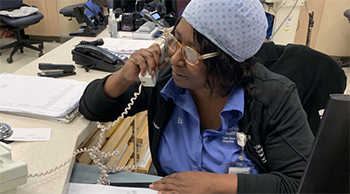
Popular Locations
- Yale New Haven Children's Hospital
- Yale New Haven Hospital - York Street Campus
- Yale New Haven Hospital - Saint Raphael Campus


Dionne Talton, a business associate on Medicine (SLA 3), can spend up to 20 minutes arranging transportation for some discharged patients. She has been involved in planning for YNHHS’ new Transportation Logistics Hub.
On a recent morning, Business Associate Dionne Talton was combing through the electronic medical record of a patient scheduled for discharge from the SLA 3 Medicine unit.
The discharge orders called for a stretcher, and the transportation company needed to know specifically which medical conditions necessitated it. Because the patient had multiple conditions, Talton had to track down their nurse to determine which prompted the stretcher order.
Talton can spend up to 20 minutes arranging transportation for patients like these, which takes her away from answering patient call bells and the unit phone, helping staff with various requests and completing clerical tasks.
She “can’t wait” for Yale New Haven Health’s new Transportation Logistics Hub, scheduled to launch next month. The Hub is designed to make it easier and faster to arrange and track transportation for discharged patients across the health system and help free up much-needed hospital beds.
When a patient is ready for discharge, a team member (such as a nurse, care manager or unit clerk/business associate) on an inpatient unit or in the Emergency Department will enter an order for transportation into the StatCall function in the patient’s Epic chart. The order will include the patient’s destination (home, skilled nursing facility, another hospital or different location), along with relevant medical information and transportation needs (such as a wheelchair-accessible van). Future plans include extending the Hub to include outpatient rides.
One of the Hub’s transportation logistics facilitators, who are emergency medical technicians or specially trained dispatchers, will receive the electronic order and, using a software platform, locate the appropriate ambulance, wheelchair van or taxi vendor that meets the patient’s needs.
Transportation companies in each YNHHS delivery network area will use the same software platform, allowing Hub facilitators to see when a company dispatches a patient’s ride, where the ride is enroute and when it arrives at the hospital. A software platform feature keeps staff informed through notifications and allows patients’ family members to receive a text message, notifying them when their loved one has left the hospital.
With real-time information, Hub facilitators can prioritize certain transportation orders. Say a patient in the Yale New Haven Hospital Emergency Department is waiting for a bed on a particular unit.
The transportation logistics facilitator can prioritize transportation for a patient being discharged from that unit and help free up a bed for the waiting patient sooner.
The Transportation Logistics Hub will also free up staff for their other duties.
“The biggest advantage of this will be the time it saves,” said Talton, who is part of the multidisciplinary team working on the Hub project.
Planning for the Hub began in 2021, when Jason Cooling, a clinical redesign consultant with YNHHS Clinical Operations, asked inpatient teams what commonly causes patient discharge delays.
Transportation came up repeatedly.
Cooling visited inpatient units, recording how much time business associates and sometimes nurses or care managers spent arranging transportation for discharged patients, which includes their time spent contacting transportation companies, gathering patient information, completing forms and waiting on hold. The time is significant, considering the more than 62,500 patient transports YNHHS sees each year.
“The Transportation Logistics Hub facilitators are there to own and streamline this process,” said Kelsey Cameron, Capacity Coordination Program manager. “They will work with transportation companies to ensure these patients get to where they need to be safely and in a timely fashion.”
The Hub logistics facilitators and software platform will also help improve vendor transportation operations over time. YNHHS and the transportation companies will have information about the busiest times for discharge transportation, whether the hospitals and transportation companies are meeting deadlines and how they can work more efficiently.
The Transportation Logistics Hub will be located in the Capacity Coordination Center with Bed Management and the Y Access Transfer Center. This will give the team line of sight into the status, priorities and flow challenges of each delivery network, according to Laura Pham, MD, executive director, Patient and Physician Access. A ribbon-cutting for the Hub is scheduled for January.
This article is part of a series that examines how teams across YNHHS are working to reposition the health system for the future by focusing on strategic priorities through a systemwide initiative called Strengthening Our CORE (Collaboration, Optimization, Resiliency, Efficiency). Multiple workstreams have been designed to improve operational efficiencies; foster innovation; and improve quality and safety for patients and employees.